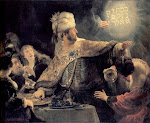We don't usually associate grammar and graffiti but we might. The Oxford English Dictionary
(OED) tells us that the word grammar is linked to the word glamor and thus magic. But the spell that graffiti puts on us is more
aesthetic than
semantic, so grammatical conventions can be ignored to free up other communicational potentials. When grammar rules are discarded in graffiti the purpose is to shake us out of conditioned consciousness and expand the meaning and aesthetic pleasure of letters. By contrast, text messagers ignore standard grammar to increase the speed of their communication.
My interest in graffiti bloomed after speaking with a young artist named Dylan Mott who had "tagged" a print of
Monet's "Regatta at St. Andresse" in an aesthetically sophisticated way that caught my attention and got me asking questions. What was that word? Right? Rick? Rigls?
When I said I couldn't read the word and asked Mott what it was, he said it wasn't a word - it was more of a design. As a teacher I was astonished to consider, sadly for the first time, that letters could be used for something other than semantic content. Upon closer inspection, I discovered that even the identity of the individual letters was uncertain. Each shape suggested, but did not settle upon, multiple possibilities, a K or an X or an R.
So it seems that, though our pipe-smoking tagger above might choose to follow grammatical conventions in his graffiti, they are not required. Many tags depart from traditional forms and uses to suggest new ways of seeing and communicating - and this is an necessary, and often enjoyable, challenge for the human mind.






























